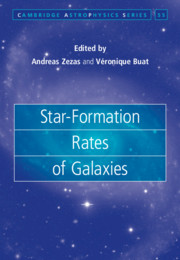Book contents
- Frontmatter
- Contents
- List of Figures
- List of Tables
- List of Contributors
- Preface
- Part I Background
- Part II SFR Measurements
- 5 Star-Formation Rates from Resolved Stellar Populations
- 6 Star-Formation Measurements in Nearby Galaxies
- 7 Continuum and Emission-Line Star-Formation Rate Indicators
- 8 Star-Formation Rates from Spectral Energy Distributions of Galaxies
- 9 Modelling the Spectral Energy Distribution of Star-Forming Galaxies with Radiative Transfer Methods
- 10 Measuring the Star-Formation Rate in Active Galactic Nuclei
- 11 High-Energy Star-Formation Rate Indicators
- Index
9 - Modelling the Spectral Energy Distribution of Star-Forming Galaxies with Radiative Transfer Methods
from Part II - SFR Measurements
Published online by Cambridge University Press: 11 May 2021
- Frontmatter
- Contents
- List of Figures
- List of Tables
- List of Contributors
- Preface
- Part I Background
- Part II SFR Measurements
- 5 Star-Formation Rates from Resolved Stellar Populations
- 6 Star-Formation Measurements in Nearby Galaxies
- 7 Continuum and Emission-Line Star-Formation Rate Indicators
- 8 Star-Formation Rates from Spectral Energy Distributions of Galaxies
- 9 Modelling the Spectral Energy Distribution of Star-Forming Galaxies with Radiative Transfer Methods
- 10 Measuring the Star-Formation Rate in Active Galactic Nuclei
- 11 High-Energy Star-Formation Rate Indicators
- Index
Summary
Knowledge of the output and three dimensional distribution of all constituents of galaxies (stars of all ages, gas, dust, cosmic rays) is a prerequisite for understanding the process of star-formation along the cosmic time, and ultimately the formation and evolution of galaxies. However, what we measure is the spatial and spectral energy distribution (SED) of galaxies. In this chapter we describe self-consistent modeling of the SED involvingradiative transfer (RT) calculations that follow the interaction between stellar photons and dust particles, and make predictions for all emission mechanisms involved. Tracing the energy flow and accounting for the anisotropy of the problem requires modelling of SEDs spanning a broad range in wavelengths and the spatial distribution of the emission. A RT modelaccurately calculates the stellar SEDs emitted by the newly-formed stars by both calculating the effect of dust attenuation throughout the galaxy, and by providing a three dimensional picture of the stellar emission of these stars. This way it produces a solution for the SFR, and the 3D distributions of all stellar components of a galaxy (stars of all ages and from different morphological components, like disks, bulges, and bars) and of the dust distribution, giving us a detailed understanding of the make up of a galaxy, both of its stellar content and of the interstellar medium structure.
Keywords
- Type
- Chapter
- Information
- Star-Formation Rates of Galaxies , pp. 204 - 224Publisher: Cambridge University PressPrint publication year: 2021



